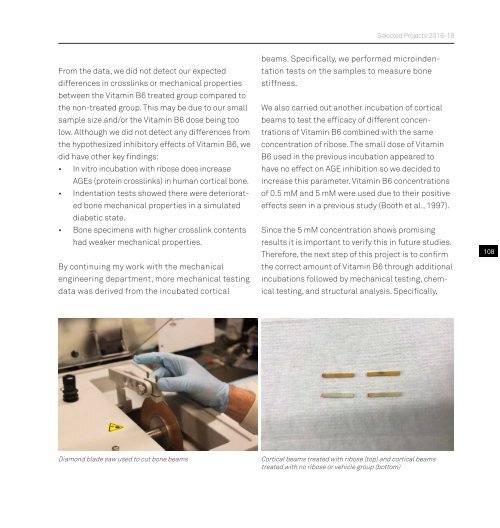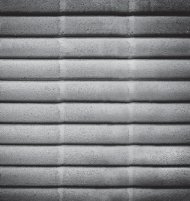Undergrad_Book_16-18_Pge_View_Print_no print marks_compressed
Create successful ePaper yourself
Turn your PDF publications into a flip-book with our unique Google optimized e-Paper software.
Selected Projects 20<strong>16</strong>-<strong>18</strong><br />
From the data, we did <strong>no</strong>t detect our expected<br />
differences in crosslinks or mechanical properties<br />
between the Vitamin B6 treated group compared to<br />
the <strong>no</strong>n-treated group. This may be due to our small<br />
sample size and/or the Vitamin B6 dose being too<br />
low. Although we did <strong>no</strong>t detect any differences from<br />
the hypothesized inhibitory effects of Vitamin B6, we<br />
did have other key findings:<br />
• In vitro incubation with ribose does increase<br />
AGEs (protein crosslinks) in human cortical bone.<br />
• Indentation tests showed there were deteriorated<br />
bone mechanical properties in a simulated<br />
diabetic state.<br />
• Bone specimens with higher crosslink contents<br />
had weaker mechanical properties.<br />
By continuing my work with the mechanical<br />
engineering department, more mechanical testing<br />
data was derived from the incubated cortical<br />
beams. Specifically, we performed microindentation<br />
tests on the samples to measure bone<br />
stiffness.<br />
We also carried out a<strong>no</strong>ther incubation of cortical<br />
beams to test the efficacy of different concentrations<br />
of Vitamin B6 combined with the same<br />
concentration of ribose. The small dose of Vitamin<br />
B6 used in the previous incubation appeared to<br />
have <strong>no</strong> effect on AGE inhibition so we decided to<br />
increase this parameter. Vitamin B6 concentrations<br />
of 0.5 mM and 5 mM were used due to their positive<br />
effects seen in a previous study (Booth et al., 1997).<br />
Since the 5 mM concentration shows promising<br />
results it is important to verify this in future studies.<br />
Therefore, the next step of this project is to confirm<br />
the correct amount of Vitamin B6 through additional<br />
incubations followed by mechanical testing, chemical<br />
testing, and structural analysis. Specifically,<br />
108<br />
Diamond blade saw used to cut bone beams<br />
Cortical beams treated with ribose (top) and cortical beams<br />
treated with <strong>no</strong> ribose or vehicle group (bottom)



